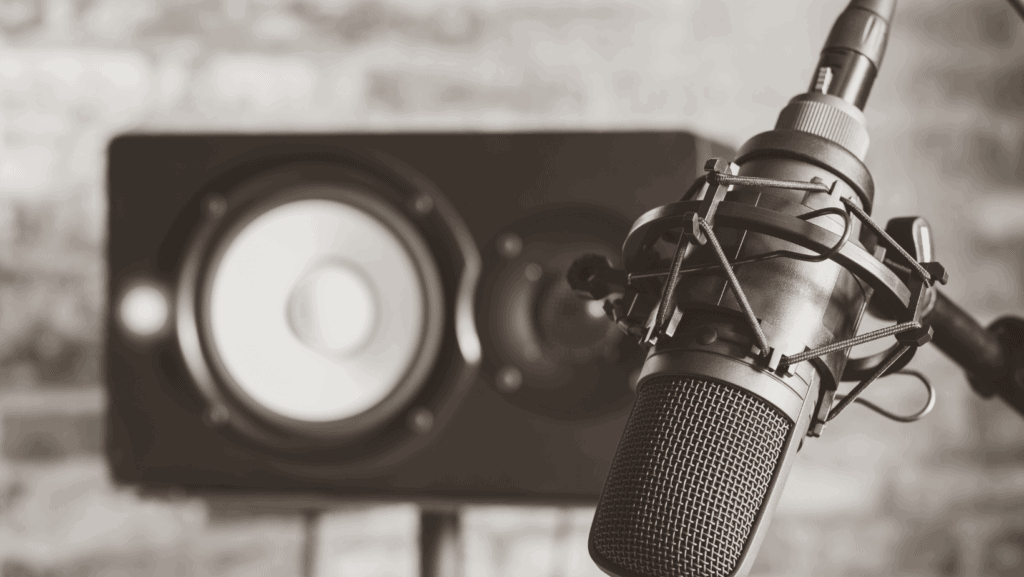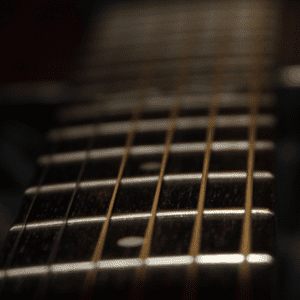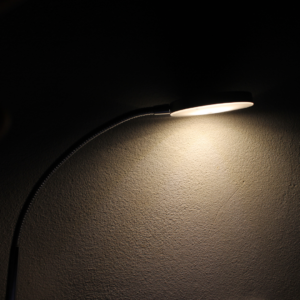
When it comes to the world of audio production, studio monitors specifically, there is no “one size fits all.” As a music producer that produces EDM, one of the major things you should consider is the studio monitor’s ability to handle and replicate low end accurately without the help of a sub-woofer.
Having had experience with a lot of studio monitors, I will present to you the five best studio monitors for EDM.
| 1. Best 5-inch woofer studio monitor for EDM: KRK RP5 Rokit G4 KRK is a household name in dance music and bass-heavy contemporary music. KRK Rokit 5 G4 is a fairly priced “industry standard” studio monitor in EDM, hip-hop, and other dance/bass-heavy genres. | Buy on Amazon | |
| 2. Best budget-friendly 8-inch woofer studio monitor for EDM: Tannoy GOLD 8 With its clean and unexaggerated response across all frequencies, Tannoy Gold 8 is just another testament to that already excellent legacy of the Tannoy range of systems. | ||
| | 3. Best budget-friendly 5-inch woofer studio monitor for EDM: Tannoy Reveal 502 With its super-attractive price, the Reveal 502 delivers way better than what other monitors (of higher prices) in the 5-inch range can deliver | Buy on Amazon |
| | 4. Best 8-inch/midrange EDM studio monitors for people not on a tight budget: Focal Alpha 80 With its crisp and uncolored sound, and a sturdy design, it’s hard to beat the Focal Alpha 80 in the world of bass-heavy music – you might never need to use a subwoofer with the Alpha 80. | Buy on Amazon |
| | 5. Best air motion transfer (AMT) studio monitors for EDM: PreSonus R80 Featuring a well-rounded and punchy low-end, wide stereo imaging, acoustic space setting to suit different listening environments | Buy on Amazon |
Best Studio Monitors for EDM Reviewed
Best 5-inch woofer studio monitor for EDM KRK RP5 Rokit G4
In the world of audio production, KRK remains a household name. When it comes specifically to EDM and other bass-heavy genres, the KRK is always the first choice for most. This explains why it is a common sight in most professional recording studios, regardless of the genre or style of music they mostly produce. However, the Rockit 5 comes in two forms, the G3 and G4 which stand for third-generation (G3) and fourth-generation (G4) respectively. The G4 which we are talking about is an improvement on the G3.
The G3 was not perfect because of its very exaggerated low end. This exaggeration would have been great for general/appreciative listening, but not very okay for critical/studio listening. The G4 has a more balanced and flat frequency response for a better soundscape. What makes it a monitor of choice for most DJs and EDM producers is the punchy low end.
With the Rokit 5 G4, the low end never goes wrong and you can’t mix with great confidence knowing your mix will translate well on huge PA systems without sounding weak. Another great feature is the redesigned front-ported bass port that helps to clean up the low end. The Rokit 5 G4 sounds clean without distortion. In most cases, you will not need a subwoofer except you are really in need of some more bass. I own a pair of Rokit 5 G4, and I use them as my second pair and monitor of choice for cross-checking my EDM and hip-hop mixes. They sound quite clean and somewhat bigger than their appearance.
It has a frequency response of 43Hz-40kHz, which means it can handle your basic bass and treble needs. Also, its new Class D amplifier increases the power capabilities compared to G3., They are pretty loud At 104dB max SPL. It also has a brick wall limiter built-in. The brick wall limiter prevents any accidental damage to the speakers. It also helps deliver consistent, balanced sound output. Aesthetically, the Rokit 5 G4 beats a lot of speakers in the market. It looks quite flashy with its iconic black and yellow and also looks strong and heavy-duty.
Pros:
- Good price for a professional studio monitor.
- Perfect for both entry-level and pro EDM producers.
- Kevlar woofer and tweeter.
- Room tuning option.
- Sounds great across all frequency spectrums and not just the low frequency.
- Looks quite attractive.
Cons:
- Not so flat, colors sound a bit.
- The low frequency might distort in some very rare cases.
Best budget-friendly 8-inch woofer studio monitor for EDM Tannoy GOLD 8
I have always been a big fan of the Tannoy range of studio monitors. Tannoy has a legacy of being a major player in the field of audio, especially PA systems. I love the Tannoy series majorly because of its flat and uncolored response across the entire audio spectrum. I own a similar pair as my primary set of monitors which is the Tannoy Reveal 802. With a frequency range of 54 Hz – 20 kHz ±3 dB you do not need a subwoofer to do the heavy lifting for you down there in the lower frequency. Also, with a maximum SPL of 110 dB, this can go as loud as you want it to be.
This is a heavy-duty studio monitor designed specifically for bass-heavy styles and genres. The Gold 8 also manages to maintain the purity synonymous with the Tannoy range of studio monitors. I can comfortably recommend this as one of the best studio monitors for EDM.
The Gold 8 is a 300 Watt bi-amped near-field studio monitor. It comes with the legendary Tannoy dual concentric driver technology, which provides superior phase coherence and point-source stereo Imaging. It has a front-firing bass port design that allows for near-wall placement and that allows for optimal low-frequency response – perfect for EDM. Lastly, the Gold 8 comes with the next generation 8-inch dual-concentric driver for optimal musical articulation and outstanding dynamics across all frequencies.
Pros:
- Eliminates the need for a subwoofer even in most bass-intensive needs.
- A clean response across all frequencies.
- Good price for an 8-inch woofer studio monitor.
- Although being a near-field monitor, it can also serve as mid-range.
- Well rounded and punchy low end.
- Built quite sturdy.
- Looks amazing.
Cons:
- The low frequency is a bit exaggerated, which might result in a not-very-perfect mix for total beginners.
- Might not be the perfect choice for bedroom EDM producers using a tiny room as their studio.
Best budget-friendly 5-inch woofer studio monitor for EDM Tannoy Reveal 502
Still from Tannoy, here is another amazing but not so popular model. Like I made mention, I own a pair of Tannoy Reveal 802, which is the bigger version of the 502s. The unique thing about the Tannoy Reveal series is its flat and uncolored response across all frequency spectrum. There is this honesty I feel whenever I listen to a piece of music on my pair of Tannoys. I start hearing things I never heard on other monitors, and that explains the “Reveal” part of the name. The Reveal 502 might not sound quite heavy in the lower frequency like other monitors but one thing is sure, you will hear just how the music sounds and you won’t run into any surprises when you play it on other playback systems like your car radio.
Being a very flat studio monitor, don’t expect it to sound “too good.” The Tannoy Reveal 502 will sound in a way that you will be forced to craft a good mix. If it sounds good and heavy on the 502, then it will sound good and heavy everywhere. The frequency response on the 502 goes from 49 Hz up to 43 kHz. Know that although you might not be able to hear as low as 49 Hz, you will still feel the vibrations and this will help you in mixing your low end. It has a built-in power amp of 75 watts. 50 watts go to the driver and 25 watts to the tweeter. The crossover is placed at 2.3 kHz. Another smart feature of the Reveal series is its “poke-resistant” tweeter. It is front-ported, and it looks quite stunning but simple in design.
Pros:
- Considering the quality of these monitors, the price is super-amazing.
- It has a “poke-resistant” tweeter.
- Flatter than most monitors within and above this price range, and that makes it perfect for mixing and critical listening.
- Looks quite sleek and simple.
- Well rounded and unexaggerated low end.
- Perfect and uncolored response across all frequencies.
- Good fit for absolute beginners and seasoned EDM producers.
- Amazing sweet spot and stereo imaging.
- Ideal for most room sizes.
Cons:
- None that I can think of.
Best 8-inch/midrange EDM studio monitors for people not on a tight budget Focal Alpha 80
First, the Focal Alpha 80 studio monitors look quite charming, heavy-duty, and beastly. The industrial/heavy-duty aesthetic matches up with the manufacturer’s description, which reads “particularly ideal for producing music which is rich in bass or which requires high power reserves.” The description is not just a marketing stunt, as I have had some personal experience with these heavy duties. The Focal Alpha 80 sounds just right for EDM. Personally, I feel every EDM producer who can afford this should at least own this as a secondary pair.
The Focal Alpha 80 comes with a decent extended low-frequency response, even at very low volumes. It has clean and wide stereo imaging and an excellent sweet spot. Controls-wise, the Focal Alpha 80 has low-frequency (LF) and high-frequency (HF) shelf controls for room tuning and placement. This is a decent all-round studio monitor with great emphasis on low-frequency extension. The Alpha 80 was specifically designed for bass-heavy electronic genres. It is also sold in pairs. For optimal placement, it is front-ported. It has a frequency response of 35Hz–22kHz, which means you might never need a subwoofer.
Pros:
- Sold in pairs.
- Goes as low as 35Hz and as high as 22kHz.
- Looks super attractive and heavy-duty.
- Built to last.
- Specifically designed for bass-heavy genres like EDM.
Cons:
- Price-wise, it is a bit on the high side as not everyone can afford it.
- A bit colored in the low frequency.
Best air motion transfer (AMT) studio monitors for EDM PreSonus R80 AMT
The key feature on the PreSonus R80 AMT is embedded in the name. The abbreviation AMT stands for “Air Motion Transfer.” The AMT tweeter of the R80 is made from a very thin folded Kapton membrane. We can find this similar design on the Adam Audio A5X tweeter. It has a superior transient response, even with the most subtle waveforms and highest frequencies. Also, it has a much wider stereo soundstage than classic dome tweeters. The low end of the R80 is also clear and punchy with an 8-inch tweeter. The basic controls include acoustic space, high-frequency (HF) Driver levels, and a high-pass (HP) Filter to help you tune the monitors to suit whatever room you are in. It has a frequency response of 40 Hz – 22 kHz and a crossover frequency of 2.6 kHz.
Pros:
- Well rounded and punchy low end.
- Wide stereo imaging.
- Perfect for both beginner and pro EDM producers.
- Acoustic space setting to suit different room acoustic scenarios.
Cons:
- Not basically low-budget.
Best Studio Monitors for EDM Buying Guide
The Most Important Thing; What Makes A Good EDM Studio Monitor?
When you are crafting a mix, you rely on your ears to guide you on what adjustments to make. By that I mean, which frequencies to boost and which to attenuate. The studio monitors you use for your playback contribute a great deal to what your ears hear. It is more like someone you rely on for information – you don’t need someone that will lie to you or tell you half-truths. In the same way, to craft accurate mixes, you don’t want your studio monitors to color the sound in any way. You want your monitors to be as honest as possible; you want it to playback the sound just the way it is. Not with a little more bass or a little less bass or little more/less anything.
Studio monitors unlike normal consumer speakers are designed to give a flat frequency response across all frequency spectrum. Consumer stereo speakers may be tweaked to produce a strong bass response and sound punchy, while good studio monitors will never emphasize particular frequencies over others. So, answering the question of “what makes a good EDM studio monitor?” I will tell you flat and uncolored frequency responses across the entire frequency spectrum.
How Can You Tell if they Are Truly Flat?
This is a tricky question, but let me give you a tip. The first time you listen to audio played through a truly honest studio monitor with a flat frequency response curve, it may not sound so appealing. The audio might sound quite messed up and unpleasantly surprising, especially if you are used to listening to the audio on consumer playback systems. This is because consumer playback systems are designed to sound impressive with exaggerated and colored frequencies. Have you ever tried crafting a mix on maybe a Beat by Dre headphone? It might sound so impressive with the headphones but the total opposite when cross-checked on a studio monitor – you will hate the mix.
Frequency Range
Because you want your studio monitors to be as accurate as possible, one of the first things you want to confirm is that the monitors you are choosing can handle the full frequency range of your recordings. Almost all types of monitors will list the lowest frequency they handle in Hz (hertz) and the highest frequency in kHz (kilohertz). For most recording or musical scenarios, a frequency response of 50Hz-20kHz will do. Actually, the overall frequency range of your chosen monitor is not as important as the monitor’s ability to reproduce all those frequencies without some distortion or variations.
The studio monitor you are looking at might claim to handle a frequency range of 40Hz-21kHz, but don’t be surprised if they fail to reproduce those frequencies evenly without any variation or distortions. You should see an indication of how much variation/distortion there will be across the frequency range your monitor claims to reproduce. This variation is expressed in decibels. For example, if a monitor’s frequency range is stated to be 40Hz-21kHz ± (plus-minus) 2dB, this shows that some frequencies may be louder or softer by as much as 2 decibels at different points across the full range. In most cases, a rating of ± 3 dB or less will provide a well-balanced sound.
Our verdict
Having considered every contributing factor like budget, frequency response, flatness, build, overall aesthetic, etc, I have come to a conclusion. My overall best goes to the Focal Alpha 80. The Alpha 80 has everything an excellent EDM studio monitor should have. The manufacturer’s description on the Alpha 80 tells it all, as it reads:
“particularly ideal for producing music which is rich in bass or which requires high power reserves.”
With a frequency response of 35Hz–22kHz, you don’t even need a sub to get things done down there in the lower frequency. You can mix your 808s, sub-bass, and bass-heavy kicks confidently on this pair.My second winner is none other than the Tannoy Reveal 502. The Reveal 502 is one the best but underrated 5-inch woofer studio monitors out there in the market. I love the honesty and purity of the 502s. With this, you can mix your EDM with some confidence knowing that no frequency is being colored or exaggerated in any way. Although they are not basically heavy-duty pairs, you can still mix your low end confidently with it expecting minimal surprises when cross-checked with larger pairs. A good practice would be to use this as a secondary pair and the Focal Alpha 80 as your primary pair – if you can afford it.
Last update on 2023-04-27 / Affiliate links / Images from Amazon Product Advertising API








